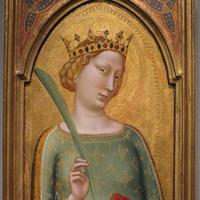More about Bernardo Daddi
Works by Bernardo Daddi

Contributor
The southern half of Italy was part of the Byzantine Empire until the later half of the eleventh century.
As a result, Italian artwork followed the shadow of the Byzantine frescoes: patterned, flat, and ethereal so as to emphasize the otherworldly divinity of the religious icons they stood for. That worked well for frescoes, but less so for paintings. Human figures were flat, badly proportioned, and generally looked like noodle-armed cadavers.
Giotto di Bondone sought to change that, introducing realism into the greater Florentine art scene, immortalizing him as the father of modern Western painting. His pupil, Bernardo Daddi, continued his work. Like Giotto, Daddi rendered the skin and flesh of his figures with realistic light sources, allowing them to come to life. They smiled, frowned, and cried out in pain with more human expressions.
However, the Byzantine Empire still held a bit of influence even with Giotto’s innovations. Daddi’s figures still had small almond-shaped eyes, which made all his figures look like they were trying to read the small print disclaimer on prescription meds. Still, it was step in the direction towards the three-dimensional perspective and realistic proportion that would proliferate throughout Renaissance works.
Like many Florentine artists at the time, Daddi was also greatly influenced by the Sienese style started by Duccio di Buoninsegna, which emphasized intimacy and lyrical sweetness. It served as the quality that set him apart from his mentor, and worked well at a time when private religious devotion became much more emotionally involved. Prayers literally asked the devoted to acknowledge the saints and Christ they were praying to as if they were actually there in front of them. Daddi’s studio, which specialized in small, intimate, and devotional panels, allowed his clients to better experience this new style of prayer.
Outside of that, not much is know about his life save for the years in which he was artistically active, from 1312-1347, likely dying soon after that time.
Sources
- “Bernardo Daddi (Italian, Active about 1312 - 1348) (Getty Museum).” n.d. The Photography of Ray K. Metzker and the Institute of Design (Getty Center Exhibitions). J. Paul Getty Museum, Los Angeles. Accessed November 26, 2018. http://www.getty.edu/art/c
- Department of Medieval Art and The Cloisters. “Private Devotion in Medieval Christianity.” In Heilbrunn Timeline of Art History. New York: The Metropolitan Museum of Art, 2000–. http://www.metmuseum.org/toah/hd/priv/hd_priv.htm (October 2001)
- Meagher, Jennifer. “Italian Painting of the Later Middle Ages.” In Heilbrunn Timeline of Art History. New York: The Metropolitan Museum of Art, 2000–. http://www.metmuseum.org/toah/hd/iptg/hd_iptg.htm (September 2010)
Featured Content
Here is what Wikipedia says about Bernardo Daddi

Bernardo Daddi (c. 1280 – 1348) was an early Italian Renaissance painter and the leading painter of Florence of his generation. He was one of the artists who contributed to the revolutionary art of the Renaissance, which broke away from the conventions of the preceding generation of Gothic artists, by creating compositions which aimed to achieve a more realistic representation of reality. He was particularly successful with his small-scale works and contributed to the development of the portable altarpiece, a format that subsequently gained great popularity.
Check out the full Wikipedia article about Bernardo Daddi











